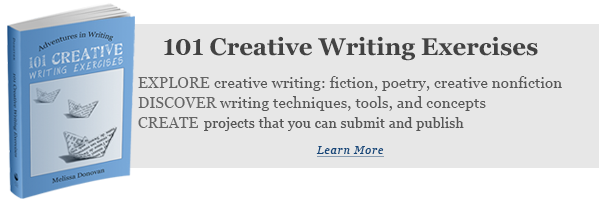Today I’d like to share an excerpt from 101 Creative Writing Exercises, a book that encourages you to experiment with different forms and genres of writing while providing inspiration for publishable projects and imparting useful writing techniques that make your writing more robust.
This exercise is from “Chapter 8: Free Verse.” It’s titled “Alliteration and Assonance.” It explores two literary devices that will make your writing more rhythmic and memorable. Enjoy!
Alliteration and Assonance
Developing a vocabulary of poetry terms and literary devices will help you better understand the writing techniques and tools that are at your disposal. It may not occur to you that you can build rhythm by repeating consonant sounds. When you know the meaning of alliteration, then this idea is more likely to influence your work.
Poetry terms, such as alliteration and assonance, show us how clever, creative word arrangements add musicality to any piece of writing, making it more compelling and memorable. These terms and the concepts they represent apply to all types of writing, not just poetry.
Alliteration is the repetition of the initial consonant sounds of words in close proximity to one another. Examples of alliteration include black and blue, we walk, and time after time.
In some cases, alliteration is used to refer to any repeated consonant sounds, even if they don’t occur at the beginning of words. An example of this would be “blue notebook,” where the b sound is repeated at the beginning of blue and in the middle of notebook.
Alliteration might also be used to describe the repetition of a consonant sound nestled in the middle or even at the end of words. Blueberry, for example, contains alliteration within a single word.
Assonance is similar to alliteration, except it deals exclusively with vowel sounds. Assonance occurs when accented vowel sounds are repeated in proximity:
Assonance allows literary writers to create fun phrases.
In the example phrase above, there are several runs of assonance. The opening a sounds in the words assonance and allows demonstrate one run of assonance. This run is marked with underlining. A second run is marked with bold lettering and occurs with the a sounds in create and phrases. Can you find a third run of assonance in the sentence?
Assonance often evokes a sense of rhyme without serving up a direct or technical rhyme. The phrase “fancy pants” is an example of this.
So, how are alliteration and assonance used for effect? Well, think about repetition in general. When you repeat something over and over, it becomes embedded in memory. Alliteration and assonance work the same way. If used correctly, these devices enhance the rhythm of a piece, making it more memorable.
The Exercise
Go through a piece of writing (your own or someone else’s) and look for instances of assonance and alliteration.
The material you work with can be poetry, fiction, a journal entry, or a blog post. Any form of writing will do.
Mark the runs of assonance and alliteration with bold, underlining, italics, or highlighting. When you’re done, read the piece aloud to get the full effect.
Tips: Double-check the runs you’ve identified for assonance to make sure they mark stressed (or accented) syllables. Watch out for sounds that are different but use the same letter (such as the a sounds in cat and cape).
Variations: As an alternative to identifying alliteration and assonance in a piece of writing, try writing a short piece with several runs in it. Or revise a page from an existing writing project to inject alliteration and assonance into it.
Applications: Musicality and repetition enrich any piece of writing. Too often, writers focus on content and not language. The study of poetry, poetry terms, and literary devices like alliteration and assonance reminds us to work on our language, word choice, and sentence structure.






i just love this site!!!!!!
thank you sooo much!!!!!!
You’re very welcome!